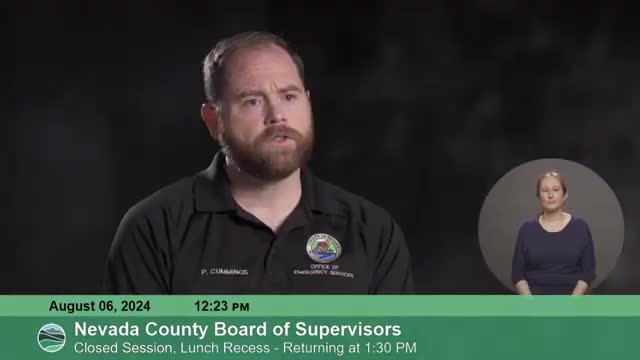Community Preparedness Saves Lives During Emergencies
August 06, 2024 | Nevada County, California
This article was created by AI summarizing key points discussed. AI makes mistakes, so for full details and context, please refer to the video of the full meeting. Please report any errors so we can fix them. Report an error »

In a recent community meeting focused on emergency preparedness, local officials and residents shared vital insights on the importance of having a well-prepared evacuation plan. Ulysses Palencia, a representative from the 211 call center, emphasized the necessity of assembling a \"go bag\" that includes essential supplies such as food, water, medication, and clothing to sustain individuals and their families for up to 72 hours during an emergency.
Palencia highlighted the critical need for those with disabilities or chronic health conditions to include necessary medical equipment in their evacuation plans. He recounted personal experiences from the devastating Camp Fire, where timely evacuations and community support played a crucial role in survival. Many residents shared stories of how neighbors helped each other escape the flames, underscoring the importance of community connections during disasters.
The meeting also addressed the different types of evacuation notifications, distinguishing between evacuation warnings and orders. Officials explained that an evacuation warning serves as a precautionary alert, while an evacuation order indicates an imminent threat requiring immediate action. The Code Red alert system was introduced as a tool for residents to receive timely updates about emergencies in their area.
Participants were encouraged to create a network of trusted individuals who can assist during emergencies, advocating for proactive communication and planning within communities. The meeting concluded with a call to action for residents to engage in preparedness discussions and utilize local resources, such as the fire safe council and 211 services, to enhance community resilience.
Overall, the meeting reinforced the message that preparedness is a shared responsibility, and being ready can significantly improve outcomes during emergencies.
Palencia highlighted the critical need for those with disabilities or chronic health conditions to include necessary medical equipment in their evacuation plans. He recounted personal experiences from the devastating Camp Fire, where timely evacuations and community support played a crucial role in survival. Many residents shared stories of how neighbors helped each other escape the flames, underscoring the importance of community connections during disasters.
The meeting also addressed the different types of evacuation notifications, distinguishing between evacuation warnings and orders. Officials explained that an evacuation warning serves as a precautionary alert, while an evacuation order indicates an imminent threat requiring immediate action. The Code Red alert system was introduced as a tool for residents to receive timely updates about emergencies in their area.
Participants were encouraged to create a network of trusted individuals who can assist during emergencies, advocating for proactive communication and planning within communities. The meeting concluded with a call to action for residents to engage in preparedness discussions and utilize local resources, such as the fire safe council and 211 services, to enhance community resilience.
Overall, the meeting reinforced the message that preparedness is a shared responsibility, and being ready can significantly improve outcomes during emergencies.
View full meeting
This article is based on a recent meeting—watch the full video and explore the complete transcript for deeper insights into the discussion.
View full meeting
